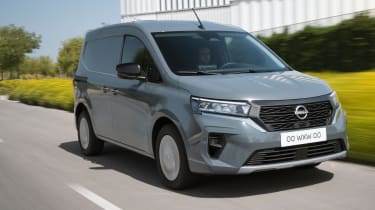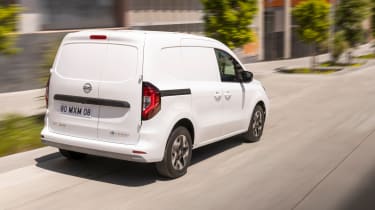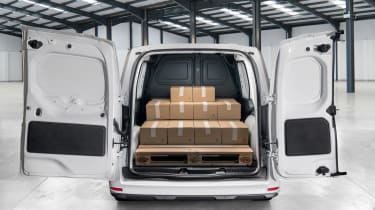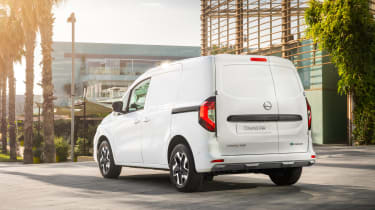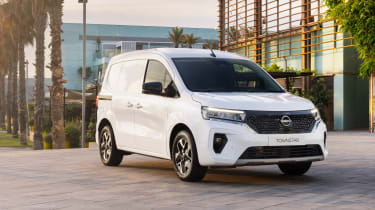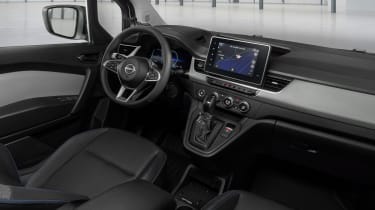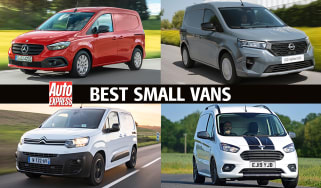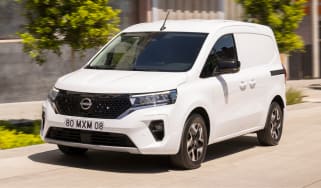Nissan Townstar van review
The Nissan Townstar looks to the future of the small van sector with a raft of tech features, and no diesel.
Nissan might not be selling its Navara pick-up truck to UK buyers these days but it can now offer a full range of panel vans again thanks to the arrival of the Townstar. A compact van, or small panel van if you prefer, the Townstar props up the Nissan light commercial vehicle range, sitting below the Primastar mid-size model and the Interstar large panel van.
The days when diesel dominated the van market are over and Nissan has been at the forefront of the switch towards electric power since it introduced the e-NV200, which claimed 63% of the UK’s electric van market between 2019 and 2020. Now the Nissan Townstar picks up where the e-NV200 left off, only offered in petrol or pure electric forms – with the EV expected to take the majority of sales.
Beyond the 1.3-litre petrol with 129bhp or the Townstar EV with 121bhp and a 45kWh battery, there are also two Townstar wheelbases to choose from, L1 and L2. The latter adds an extra 426mm to the length of the van and an extra cubic meter of carrying capacity, creating a choice of 3.3 or 4.3 cubic metres load volume for customers. Payloads are determined by powertrain choice as well as wheelbase, so the petrol models can carry 840kg (L1) or 846kg (L2), while the electric versions are rated at 612kg (L1) or 788kg (L2). A five-seat crew van will eventually be offered too.
There’s a wide range of trim levels offered on the Townstar, by van standards at least. Customers can select from a familiar-looking Nissan hierarchy that starts with Visia, then extends through Acenta and Tekna to the Tekna+. All models get a full-width bulkhead, 60:40 split rear doors and a nearside sliding door to access the load area, but the L2 variants get an off-side sliding door as well. Standard kit on Visia models also includes remote central locking with deadlocks, air-conditioning, electric heated mirrors, automatic headlights and automatic wipers.
You need to step up to Acenta to get the 8-inch colour touchscreen display with Apple CarPlay and Android Auto smartphone connectivity but it’s probably worth it for £1,000. Especially given the cruise control, climate control, rear parking sensors and AEBS automatic braking that’s thrown-in at this level. Tekna adds navigation, front parking sensors and a rear camera, plus keyless entry and start for an extra £1,300. For another £1,300, you can get the Tekna+ model which comes with 16-inch alloy wheels and a lot more driver assistance tech.
Platform sharing is an important thing to get your head around when buying a van. The cost of developing a brand new vehicle from scratch and the simple, utility-focused design of light commercial vehicles leads manufacturers to club together and share the load.
It means that buyers are often confronted with various versions of what is ostensibly the same van, wearing different badges. The Nissan Townstar, for example, uses the same platform as the Renault Kangoo and the Mercedes Citan, or the Kangtoo E-Tech and eCitan if you’re talking about their respective electric versions.
Look further afield and the Townstar’s core rival is the compact van sold by the Stellantis group brands, and Toyota. You can get that in Vauxhall Combo, Citroen Berlingo, Peugeot Partner, Fiat Doblo and Toyota Proace City guises, all of which are available with electric power, too. There’s also Volkswagen’s Caddy, which will share its underpinnings with the next Ford Transit Connect.
For the van buyer, it means lots of choice but when you’ve narrowed the search down to versions of the same vehicle from different brands, the final decision may come down to matters of price, equipment and the quality or location of the local dealer.
The Nissan Townstar starts from just under £20,000 in petrol form with the Townstar EV coming in at a hefty £8,000 more expensive. That kind of price differential is fairly standard in today’s market and it means that operators need to weigh-up the potential savings associated with running the EV version carefully. With the right usage patterns though, in urban locations (especially those with low emissions zones) an electric van can be very cost effective over the long term.
Overall, the Nissan Townstar is a strong compact van offering from Nissan and the brand’s focus on the electric version makes sense. The 183-mile range of the Townstar EV is competitive compared to rivals and while it doesn’t pull up any trees on the performance or handling front it’s comfortable, practical and has some high-end tech features, if you’re prepared to pay for them. If your business is auditioning for an urban runabout or last-mile delivery vehicle, this Nissan could play a starring role.
MPG, CO2 and Running Costs
There’s no diesel option in the Nissan Townstar line-up and that’s still a relatively novel approach, even in a small van market where diesel is very much losing its former dominance.
Nissan, of course, will tell you that an oil-burner isn’t necessary when the 1.3-litre petrol can return between 38 and 44mpg on the WLTP combined cycle with emissions of 154 to 171g/km. Those numbers are for the L1 variant, the L2 being marginally less efficient, but with the diesel engine in the Townstar’s Renault Kangoo sister car capable of over 53mpg, heads could be turned.
The Townstar EV has a 45kWh lithium-ion battery and an impressive WLTP combined range of up to 183 miles. It can charge at up to 11kW as standard which equates to a full charge in 3.7 hours if you find a suitably fast charging point, while a standard 7.4kW home wallbox will do the job in seven hours. From the Acenta grade upwards, however, there’s a 22kW AC charging capability and 80kW rapid charging is supported. That means you can get zero to 80 per cent charge in 2 hours at 22kW or 42 minutes at the right DC rapid charger.
All models come with two charging cables, one for a domestic plug socket and a type 2 cable for home wallboxes or public charging points.
Load Space and Practicality
Whether you choose petrol or electric power for your Nissan Townstar, there’s no difference in the size of the load area. The L1 model can carry 3.3 cubic metres of cargo, while the L2 will squeeze 4.3 cubic metres inside. The load lengths are 1,806mm and 2,230mm for the L1 and L2 respectively.
Even the L1 can take a pair of Europallets and comes with a single sliding side door as standard. On the L2 models, the twin sliding side doors are actually wider, growing from 615mm to 831mm, and you can load a Europallet through them.
There is a difference in payload capacity derived from the fact that while the L1 petrol model has a 1,337kg kerbweight, the Townstar EV’s battery takes it up to 1,608kg. The maximum payloads in the petrol are 840kg for the L1 and 846kg for the L2 but the EV only manages 612kg and 788kg for the two versions respectively. Both models can tow a 1,500kg braked trailer.
All models get a plastic bulkhead separating the cabin from the load area. There’s no load-through option to poke longer items through into the cabin because the clever hinged bulkhead isn’t being made available in right-hand drive models.
Reliability and safety
As is so often the case in commercial vehicles, the entry-level specification isn’t particularly well-endowed with safety kit. Townstar Visia models have a driver’s airbag, tyre pressure monitoring, hill hold assist, a full-width bulkhead and load-lashing points in the rear. You need to go for the Acenta trim to get the AEBS intelligent brake assist and reverse parking sensors.
The top-of-the-range Tekna+ model features the 360-degree All View Monitor set-up that makes it extremely difficult to dent your Townstar, plus Park Assist, Blind Spot Intervention, traffic sign recognition and driver attention alert. If you choose the Townstar EV in Tekna+ trim you also get the full Nissan ProPilot driver assistance package which includes intelligent cruise control, collision warning and lane keeping assist.
All Nissan Townstar models get a five-year/100,000-mile warranty, and there’s eight years of cover for the battery in the Townstar EV with the same 100,000-mile limit.
Driving and Performance
With no diesel Townstar, Nissan envisages the Townstar EV being the big seller, ably supported by the cheaper petrol option for drivers doing longer distances.
The petrol is a 1.3-litre four-cylinder unit with 129bhp and 240Nm of torque at 1,600rpm. Mated to the standard six-speed manual gearbox it’ll hit a 114mph top speed. The Townstar EV uses a single electric motor producing 121bhp and 245Nm, all of which is sent to the front wheels.
As you’d expect for an electric van, the Townstar EV steps off the line very smartly and occasionally struggles for traction, spinning a wheel if you’re over-zealous with the throttle, such is the low-end torque on offer. As speed increases though performance is modest but adequate for the kind of urban use the van is likely to encounter. 0-62mph takes 14 seconds in the L1 or 15 seconds in the heavier L2.
There are three settings for the regenerative braking system in the EV but even the strongest B3 setting doesn't slow you down as much as we'd expect when you lift off the throttle. Eco mode dulls the throttle response slightly and makes other changes to try and conserve the battery’s charge.
The Nissan Townstar feels like a very competent customer on the road. We drove the electric version on the streets of Paris and found a comfortable ride that was on the firm side but well damped enough to take the edge off the bumps. It never felt harsh or rattly, even over cobbled streets and severe speed humps with no load in the back.
That firm suspension also helps keep the vehicle’s weight in check. There isn’t much body roll and sharp corners can be swept through without fuss. The small, thick-rimmed steering wheel feels good in the hands but the steering itself is on the light side and quite vague. The seats are particularly good, soft-enough and supportive.
With reach and rake adjustment on the steering column, finding a very comfortable driving position for anyone around six-feet tall is a cinch, as we found out first hand. That’s with the driver’s seat at the very back of it’s available travel though, so very tall drivers could find the space a little more cramped.
As you’d imagine, progress in the Townstar EV is extremely quiet. Wind noise and a slight whine from the powertrain is all you hear in the cabin. Outside, Nissan has given the van ‘Canto’: the specially developed sound effect that features on the Japanese brand's electric passenger cars. It’s a gentle note designed to warn pedestrians at low speeds that pulses more loudly when the Townstar is reversing.
Cab and interior
The Nissan Townstar cabin is robustly built of tough plastics with some attractive detailing and contrasting finishes to raise the tone. Van drivers need plenty of cubbies to store items and avoid cluttering up the cab, and the Townstar definitely has some interesting solutions in this regard. There’s a deep glovebox that slides out like a filing cabinet drawer and a flip-top shelf ahead of the driver with charging ports inside. The latter space is a good option for charging a phone and keeping it out of the driver’s line of sight to avoid any temptation, but there is also a dedicated holder in case the phone is needed for hands-free navigation or making calls.
The centre console contains another storage bin under the armrest. The plastics here aren’t of great quality and the whole unit felt a little wobbly on our test van. Elsewhere the controls are easy to grasp with metallic-ringed dials for the heating and ventilation system, plus you get piano-key type buttons under the central screen for quick access to the important features.
The 8-inch touchscreen on Acenta models and above isn’t the sharpest you’ll come across but it has a clear menu system and large spaces to press, making it simple enough to use on the move. Most models get a 4.2-inch instrument display but the Townstar EV in Tekna+ spec features a 10-inch screen behind the steering wheel that looks a lot more impressive.
Van dimensions
Body style | Height | Width | Length |
L1 van | 1,864 | 1,860mm | 4,486mm |
L2 van | 1,854 | 1,860mm | 4,910mm |
Load area dimensions
Body style | Height | Width | Length | Volume |
L1 van | 1,215mm | 1,570mm | 1,806mm | 3.3m3 |
L2 van | 1,215mm | 1,570mm | 2,230mm | 4.3m3 |

